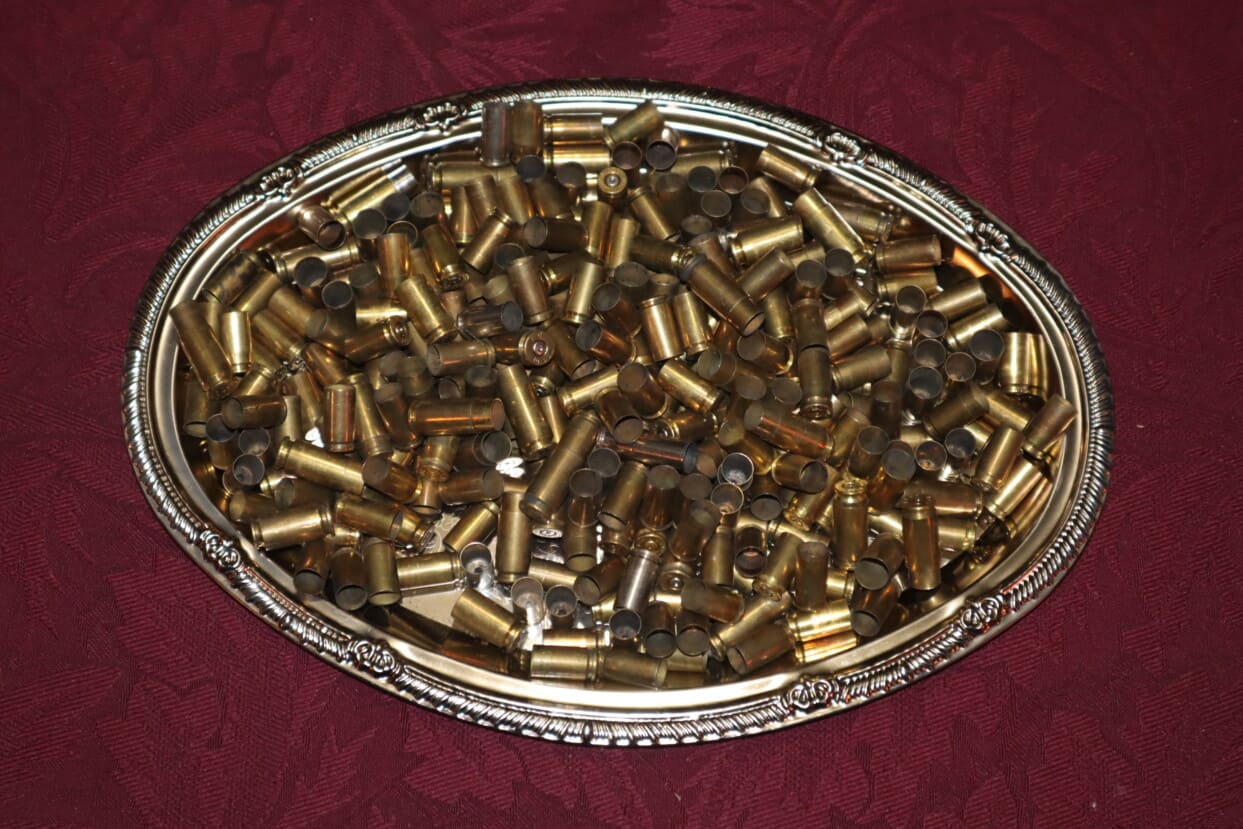When you shoot a gun, the bullet goes out to hit the target and the case either stays in the chamber of a revolver or is ejected from the ejection port of a long gun or a semi-automatic pistol. What happens to all those cases?
There are five options for dealing with a spent case:
- Use them to reload ammunition
- Recycle them
- Discard them
- Use them to make souvenirs and other decorative items
- Store Them
Reloading Spent Cases
The choice of what to do with the cases depends on their caliber, what they are made of, and their condition.
We pick up the cases on our outdoor ranges after we shoot. It helps keep the range looking neat and it prevents the lead in the primers from leaching into the ground and potentially harming wildlife or polluting the stream that runs through our back yard.
When the cases are in good condition, of suitable caliber, and made of the right materials, we reload them.
With the current shortage in ammunition, this is the only way to have enough ammunition on hand to supply our Concealed Weapons classes when the students are unable to find the right ammunition at the store.
The Calibers We Reload
You have to buy a separate set of dies for each caliber. Currently we are reloading .38 Special, .357 Magnum, .357 Sig, 9mm, and .45 in handgun calibers. Rifle calibers we reload include .223, 5.56, .300 Blackout, and 6.5 Creedmore.
We plan to expand to .45 Long Colt, .308, and 30-06 cases as we obtain the right dies. We are open to reload other calibers upon request. Other calibers that can be reloaded include .380, .40 S&W, and any other centerfire cartridge.
We don’t reload smaller calibers such as .22 because they are rimfire. That means the primer is in the rim of the cartridge base, rather than in the center as it is in centerfire ammunition.
Centerfire ammunition has a replaceable primer, which makes it safer for reloading. Smaller rounds are more likely to be rimfire because the firing pin has to crush the rim of the cartridge to ignite the primer. Also, the case head is so small there is not room for a separate primer.
The Criteria for Condition
We don’t reload cases that are split, or have thinned areas, or have enlarged primer pockets, or where the case head is separating from the body of the case. These defects indicate that a reloaded case will not work right and would be dangerous to try to reuse.
Higher pressure loads, such as those in long guns, are more likely to split. Handgun cases are more likely to remain in good condition for reloading.
The Materials We Reload
Brass is an alloy of copper and zinc. It is inexpensive, soft enough to expand and fill the chamber, hard enough to avoid splitting, smooth enough to avoid scratching the gun, and unlikely to spark.
It can be reloaded many times. It does have a tendency to tarnish but that is easily removed by tumbling the brass in a medium such as crushed walnut hulls or ground up corncobs. We reuse brass.
Steel cases are harder than brass, making them more difficult to work on a press. You get fewer reloads from a steel case and you have to be aware of which primer it uses because some primers are more dangerous for reloading. We don’t reuse steel.
Aluminum cases are not designed for reloading. I went to a few internet forums and found that people try it anyway, usually with diffident results. We don’t reload aluminum cases.
Recycling Used Cases and Bullets
According to this website, the metals you can recycle are steel, aluminum, copper, silver, brass, and gold. Scrap yards buy metal, sort it, shred it, melt it, remove impurities, and reassemble it into bars for reuse.
According to this website, steel is currently bought at $265 per metric ton on the East Coast of the United States. Peruse the site for more numbers, but ultimately you have to do a great deal of business to have enough cases to recycle.
The larger indoor ranges are likely to recycle the cases they cannot reload. Recyclers will come pick it up for them. Smaller ranges likely will not have enough recyclable metal to make this workable.
Indoor ranges have a trap at the back of the shooting range that captures the bullets. These are emptied and the used bullets are recycled back into metal.
Some Spent Cases Are Discarded
As much as we like to reuse whatever we can, some cases are the wrong material, or too damaged, or too tarnished to qualify for reloading.
Creative Options for Spent Cases
Not everything has to be reused the way it was used the first time. I did a little research and found some neat ways to reuse spent cases. Actual cases and bullets that have been fired can be recycled into nifty novelty items that would make great gifts for the gun lovers on your list.
Options include glasses, a ball point pen, a corkscrew, and a necklace. Coolest of all is a set of earplugs attached to spent cases.
If you are a do it yourself type, you can make your own jewelry from spent cases and fired bullets. Make sure you clean each piece well to remove lead residue before you work with it.
Use a primer punch to place strategic holes for stringing cases through a necklace or suspending them from a charm bracelet. Glue backings on old case heads to make pretty earrings. Fashion two bullets together with a small chain to make cufflinks.
Glue bullets and cases around the edge of a picture frame and snap a photo of yourself decked out for hunting season. String them up as Christmas decorations. Hang them from your rearview mirror like fuzzy dice.
Make a belt out of them. Rambo wore his ammunition diagonally like a military sash, but you can wear your old cases around your waist.
Glue them to hair ornaments and barrettes for a subtle display of your Second Amendment sentiments.
Storing Used Cases and Bullets
In the absence of a pressing need to clear out space, spent cases and bullets can be stored. We have a multi-ton dirt berm at the end of our pistol range. The bullets burrow into the berm after they pass through the targets.
They will stay there until enough of them are lodged in the berm to justify digging them all out. Then they can be repurposed or recycled.
The Point of This Discussion
Don’t be distressed about what happens to the ammunition you shoot. Range owners take their responsibility seriously. We know the dangers of lead exposure and we have safeguards in place to minimize your exposure.
You can be a good steward of the land while you enjoy your Second Amendment rights.
Keep reading our blog to learn all about guns and your Second Amendment rights. Watch us on our Double Eagle Gunworks YouTube channel for helpful videos on gun related topics.


